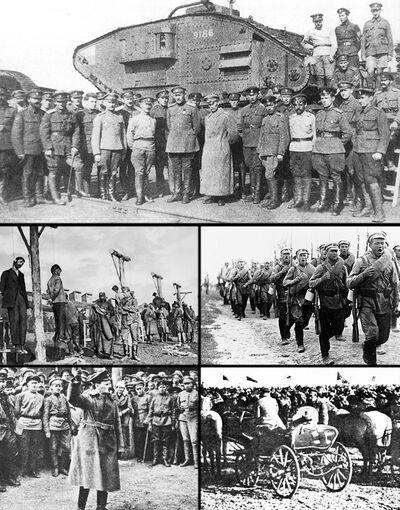Molvanian Civil War
| Molvanian Civil War | ||||||||
|---|---|---|---|---|---|---|---|---|
 Clockwise from top: Soldiers of the Army of the Northern Kargaks in 1919; a Tsarist Molvanian infantry division in March 1920; Bolshevik troopers of the Red Cavalry Army; Kinsberg Kucher in 1918; hanging of rebels in Davinislavic by Wolfswood soldiers, April 1918. | ||||||||
| ||||||||
| Belligerents | ||||||||
|
Foreign Intervention |
|
Reactionary and Fascist Forces | ||||||
| Commanders and leaders | ||||||||
|
|
| File:Molvanian Fascist.png Vladamirovich Nasspuit | ||||||
| Strength | ||||||||
| 4,000,000 White-aligned Troops | 4,500,000 Bolshevik Troops | Around 600,000 at height | ||||||
The Molvanian Civil War was a multi-party conflict in the Tsardom of Molvani immediately after the 1919 Molvanian Mutiny and November Revolution, as many factions vied to determine Molvani's future. The two largest combatant groups were the Red Army, fighting for the Bolshevik form of socialism led by Leonid Volkhov, and the loosely allied forces known as the White Army, which supported the Molvanian Monarchy (who led the Whites until 1923), economic capitalism and conservatism or were simply anti-bolshevik.
Background
1919 Mutiny
In September 1919 there was a mass, organised mutiny within the Molvanian 5th and 8th Armies which spread to a number of other units. The mutiny came at a crucial moment during the Battle of Gvodsnor and only the swift intervention of General Petrovich's Reserve Cavalry Corps kept the Germanan 11th Army from breaking through the Molvanian frontline. The mutiny inspired similar but much smaller actions in other units and the crackdown by Molvanian High Command was harsh and involved multiple shootings. Order and morale in Molvanian front line units dropped following each incident and eventually, in the Treaty of Evinberg, Molvani was forced to pull out of the war, facing mass mutiny and desertion. The navy remained mostly loyal to the Tsar and the army was divided in its support.
November Revolution
As a culmination of issues that had plagued Molvani for centuries, along with the sudden unrest brought on by the mutinies, the November Revolution began on 1st November 1919. The 5th, 6th and 8th Armies of the Molvanian Army split up entirely and reorganised organically into the Tsarist Army of Ryngorod and the Molvanian Army of Revolt. On the 4th-10th November, they fought the Battle of Danislavic and the MAR won, pushing the TAR back. The Army of Revolt, under the command of Vladamirovich Nasspuit, a former Colonel in the 5th Army, marched on Ryngorod and expelled the Tsar from the Winter Palace. On the 27th of November, the Provisional Ryngorod Republic was declared and the Tsar and his family fled to Tsarigrad.
The Republic elected Konstantin Moskvin as the President of the Ryngorod Republic and declared the 'Revolution of November' over. Both the Republic and the Tsardom claimed de jure dominion over all of Molvani, a de facto map of ownership has never been created as there is no way of telling where either side held dominion as the period of Republican-Tsarist opposition was extremely short.
December Anarchy
The first of only three Declarations of State made by the Provisional Ryngorod Republic was made by President Moskvin on the 1st of December. It called representatives from the different regions of Molvani to Ryngorod to form a new republican government. This included Churkin Danilovich, a Kargak Cossack and a minor state official from Yegorovich named Josef Viktorivich Stalin. This mixed delegation met on the 7th of December and it quickly became clear that there was a major division. Delegates from the south and west of Molvani overwhelmingly supported a Communist or Socialist system while from the north and east the delegates were almost entirely conservative, liberal, anti-leftist or outright Tsarist. Negotiations broke down swiftly with Vladamirovich Nasspuit and his far-right Fascists and Reactionaries were the first to leave and took with them a draft of 'Blueshirts' Nasspuit's uniformed paramilitary supporters.
News came the following day that in Yegorovich there had been an uprising, workers led by Kinsberg Kucher (secretly implanted in Molvani by Germana in 1918) had risen in rebellion and many of the leftist representatives left immediately upon hearing the news to raise their own troops. The remaining delegates that remained loyal to the new government, the Tsar or were simply willing to support anyone against the Bolsheviks. On the 12th an ambassador arrived at Tsarigrad from the republic and was recieved by the Tsar in the Autumn Palace. The two came to a quick agreement, the Tsarist forces and the Republican forces would be allied for the duration of conflict, the idea being that a post-war conference would decide Molvani's future.